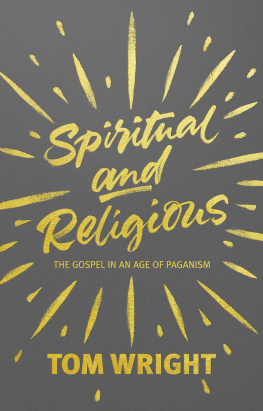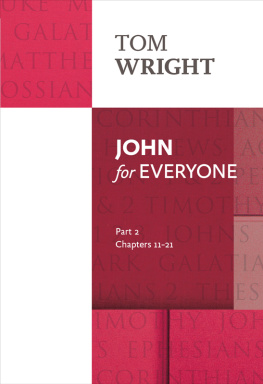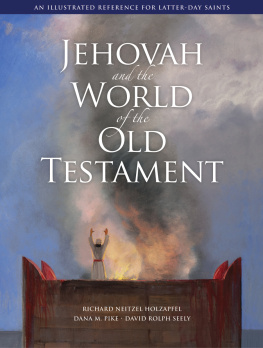copyright Nicholas Thomas Wright 2011, 2018, 2019; introductory material and glossary
All rights reserved. No part of this book may be reproduced or transmitted in any form or by any means, electronic or mechanical, including photocopying, recording, or by any information storage and retrieval system, without permission in writing from the publisher.
Preface
The first thing that happened in the life of the church was translation . On the Day of Pentecost, Gods powerful wind swept through Jesus followers, filling them, like the sails of a great ocean-going sailing ship, so that they could take Gods good news to the ends of the earth. And they found themselves speaking other languages, so that everyone in the crowd could understand.
Part of the point of Jesus message, after all, is that its about God coming to people where they are, not sitting back sternly and waiting for them to come to him. Not for nothing does John call Jesus the word of God. Theres no point speaking a word that nobody can understand.
So, right from the start, they translated. Sometimes it happened, as at Pentecost, by the direct action of the holy spirit. Mostly, though, it was through people eagerly turning the message into other languages. Much of the time, Jesus himself spoke Aramaic, an updated dialect of Hebrew, but the gospels are written in Greek. Greek was everybodys second language at the time, a bit like English in many parts of our world today. So, since the message was designed to be good news for everyone, not just native speakers of one language, it was important to translate it. Once begun, the process continued.
It took fifteen hundred years for the whole Bible to appear in English, but once that had happened particularly through the work of one of my lifelong heroes, William Tyndale (d. 1536) the idea caught on quickly. Several translations appeared during the sixteenth century, culminating in the King James (Authorized) Version at the start of the seventeenth. And in the twentieth century, too, there have been several new English versions. Some have been quite strict translations, almost word for word; others have been paraphrases, trying to convey the message in a looser, less formal way.
Two questions, then: is this new version really a translation, or a paraphrase? And why do we need yet another one?
Its a translation, not a paraphrase. I have tried to stick closely to the original. But, as with all translations, even within closely related modern European languages, there are always going to be places where you simply cant do it word by word. To do so would be correct at one level and deeply incorrect at another. There is no safe option: all translation is risky, but its a risk we have to take.
This is particularly so when the language in question is, in the technical sense, dead. Nobody today speaks first-century Greek, so we cant simply phone a native speaker and ask what they mean by a particular phrase. Even if we could do so, theres no guarantee that the person we called would necessarily understand all that a New Testament writer has put into a word, phrase or sentence. The New Testament, after all, is telling a story which is deeply rooted in the ancient scriptures of Israel. Often its key technical terms mean something more like their equivalents in Hebrew than their regular usage in secular, non-Christian Greek.
Greek often goes quite easily into English, but not always. A couple of examples may help, one about little words and one about big ones.
Greek often uses little words to join sentences together; English often makes do with punctuation. (That last sentence is a good example: I could have written but English often makes do with punctuation, but the semicolon does the job more elegantly.) St Paul, in particular, uses the little word gar a great deal to connect his sentences, and English versions often translate it as for in the sense of because. But people today dont often use the word for in that way. It sounds formal and stilted, especially if you repeat it over and over as Paul does. People dont say it much in conversation, and a lot of the New Testament is more like conversation than like a great literary work. So, on various occasions, I have done it differently. If by the Spirit you put to death the deeds of the body, you will live, writes Paul in Romans 8.1314 in the NRSV translation, for all who are led by the Spirit of God are children of God. I decided, instead of that for, to put in the colloquial English you see: all who are led by the spirit of God, you see , are Gods children. Or, sometimes, I have linked the two points by asking a question, and answering it: there is no condemnation for those who are in the Messiah, Jesus! Why not? Because the law of the spirit of life in the Messiah, Jesus, released you from the law of sin and death (Romans 8.12). That Why not? Because... is how Id say it, if I were Paul giving a lecture.
Or take the bigger words. Some of the great New Testament words are like ships loaded with several different kinds of cargo, and we simply havent got words that can carry all that freight today. Thus, for instance, the English word righteousness has been a technical term in theology for many years, and has often been used to translate the Greek dikaiosyn . But for many English speakers today it means self- righteousness: its become a proud, churchy sort of word. So what are the alternatives? We simply havent got them. We want a word that can pack justice, covenant faithfulness, and right standing or relationship all into the same hold, and can set off, with this cargo safely on board, to sail around the world. There isnt such a word. So I have done my best to bring out the different flavour which dikaiosyn seems to carry in this or that passage. I have done the same with Christos : most translations simply say Christ, but most modern English speakers assume that that word is simply a proper name (as though Jesus were Jesus Christian name and Christ were his surname). For all sorts of reasons, I disagree; so I have experimented not only with Messiah (which is what the word literally means) but sometimes, too, with King. These experiments are risky. But they also present a glorious opportunity.




















